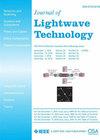Enabling Technologies to Achieve Beyond 500 Gbps Optical Intra-Connects Based on WDM Visible Light Laser Communication
IF 4.1
1区 工程技术
Q2 ENGINEERING, ELECTRICAL & ELECTRONIC
引用次数: 0
Abstract
The rapid development of emerging technologies has led to a significant increase in data traffic, posing challenges for data centers in terms of storing, transmitting, and processing large volumes of information. Intra- and inter-datacenter connections with high bandwidth, low latency, high reliability, and high energy efficiency are in great demand. Traditional electrical communication is becoming increasingly inadequate, while optical communication has emerged as promising solutions. Visible light laser communication (VLLC) utilizes the spectrum ranging from 380 nm to 700 nm and has the advantages of offering high transmission rates, cost-effectiveness, and simple system structures. In this paper, enabling technologies including high-bandwidth laser diodes, advanced modulation formats, and artificial intelligence (AI)-based equalization schemes are introduced. A compact 50-channel VLLC interconnect system has been developed, achieving ultra-high-speed short-range VLLC transmission with a record data rate of 534.51 Gbps, showcasing the potential of VLLC as a high-capacity and cost-effective optical intra-data center connection solution.求助全文
约1分钟内获得全文
求助全文
来源期刊

Journal of Lightwave Technology
工程技术-工程:电子与电气
CiteScore
9.40
自引率
14.90%
发文量
936
审稿时长
3.9 months
期刊介绍:
The Journal of Lightwave Technology is comprised of original contributions, both regular papers and letters, covering work in all aspects of optical guided-wave science, technology, and engineering. Manuscripts are solicited which report original theoretical and/or experimental results which advance the technological base of guided-wave technology. Tutorial and review papers are by invitation only. Topics of interest include the following: fiber and cable technologies, active and passive guided-wave componentry (light sources, detectors, repeaters, switches, fiber sensors, etc.); integrated optics and optoelectronics; and systems, subsystems, new applications and unique field trials. System oriented manuscripts should be concerned with systems which perform a function not previously available, out-perform previously established systems, or represent enhancements in the state of the art in general.
 求助内容:
求助内容: 应助结果提醒方式:
应助结果提醒方式:


